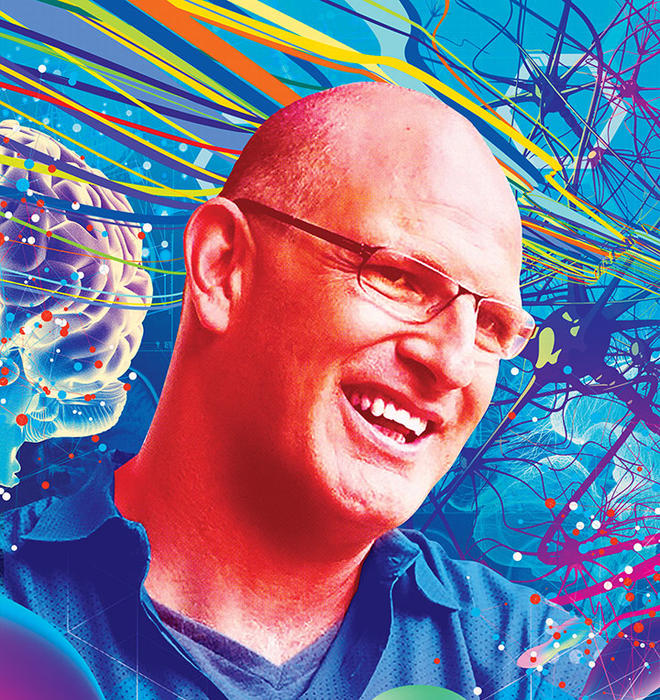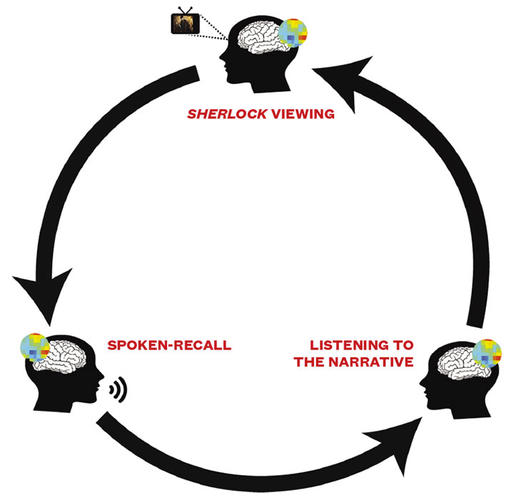
Clicking: How Our Brains Are in Sync
You know how you sometimes have a truly great conversation — when there’s a mutual understanding and the discussion just flows? Uri Hasson, a Princeton professor of psychology and neuroscience, is studying the mechanics behind conversations like that. Specifically, he researches what’s happening when ideas are effectively transferred between brains during verbal communication. “You know when you click with someone,” says Hasson: It’s sort of like dancing with a partner; neither person is doing exactly what the other is, but the moves are complementary.
Hasson’s research, which uses the tools of modern neuroscience in experiments that mimic real life, points to the idea that communication is really “a single act performed by two brains.” A speaker’s brain waves generate a sound wave — speech — that in turn influences the brain responses in the listener and brings them into alignment with her own. Hasson calls the outcome of this process brain coupling, and the stronger the coupling — the more aligned the speaker-to-listener brain patterns — the better the mutual understanding. (Dancing, clicking, and coupling aside, he’s referring to all effective communication, not necessarily the romantic kind.)
Hasson is digging into the big questions of how we exchange ideas, thoughts, and memories with others — and, at a more fundamental level, how the mind works. His tools include functional magnetic resonance imaging (fMRI), which tracks how activity in different brain regions changes in response to stimuli, spoken stories, and a collection of movies and TV episodes.
That library includes two fast-paced BBC television series, Sherlock and Merlin. In one study published last year, Hasson and his colleagues had participants lie in an fMRI scanner while watching part of an episode of one of the two shows, which were chosen because they were engaging and had twisting plots likely to be easily remembered. Later, one person was recorded recounting the episode while being scanned again, this time in the dark. Then, people who hadn’t seen the shows listened to that recording. These participants were scanned as they mentally constructed the show from what they heard.
On the face of it, watching a video clip, recalling it later, and imagining it from someone else’s description are very different cognitive processes. But Hasson found that the brain patterns across those processes were similar in certain higher-order areas. That trend was scene-specific, so that (spoiler alert!) when Sherlock gets into a cab driven by the man he has realized is responsible for several murders disguised as suicides, there were shared patterns of brain activation in study participants regardless of whether they were watching, remembering, or imagining that scene.
The experiment also revealed something about memory. The more similar the patterns in the brain of the person who originally viewed the episode and the person who mentally constructed it when listening to the description, the better the transfer of memories from the speaker to the listener, as measured by a separate comprehension test. The findings suggest that the same areas used to recall and reconstruct a memory are involved in the construction of someone else’s memory in our imagination. “Perhaps the key function of memory is not to represent the past, but to be used as a tool to share our knowledge with others and predict the future,” Hasson says. He expects the results would be even more pronounced in real-time or face-to-face conversations.
Hasson’s goal is to get as close as possible to multidimensional, real-life experiences, within the limits of available technology and scientific rigor. His work is rooted in the idea that the world is complicated. It’s messy. It delivers to us a constant stream of information and experiences that we process, consciously and not, as we move through our days. “He wants to work with things that are as rich as real life right now,” says Kenneth Norman, professor and psychology department chair at Princeton and a collaborator of Hasson’s.
That’s different from traditional neuroscience research, which has tried to distill that richness to very simple experiments — say, studying perception by scanning a study subject’s brain while she’s looking at objects in isolation on a gray background. Those simple experiments build to more complex ones. Hasson is starting from the other end of things, using more complex situations and stripping away some of the variables to make them simple enough to study. He hopes he and the other researchers will meet in the middle to produce a more complete picture of what’s going on in our brains.Hasson grew up in Israel. He started off interested in philosophy and studied it at the Hebrew University of Jerusalem. But he wasn’t satisfied with how that discipline wrestled with the question of how the mind works: “It was always talking about possible worlds, but I wanted to find out what’s going on in the real world.” So he turned to the more empirical world of cognitive science as an undergrad and master’s candidate, then earned his Ph.D. in neurobiology at the Weizmann Institute of Science. That was more his speed. “Neuroscience inspires me to understand how the brain performs all the amazing, daily-life things it does, from perceiving to remembering to talking and thinking,” he says.
Hasson’s approach was different from the start. While at the Weizmann Institute, he set out to investigate how similarly different human brains operate. Usually that kind of study is done by performing one of those controlled experiments with very simple stimuli and then using the results to map and compare the brain regions that are involved. Hasson and his colleagues wanted to explore the question under more natural conditions, so they turned to an exponentially more complex stimulus: a Clint Eastwood film. The researchers had study subjects watch a 30-minute clip of the spaghetti western The Good, the Bad and the Ugly while undergoing fMRI scanning.
“To my surprise, people had very similar responses,” Hasson says of the results, which were published in Science in 2004. You might expect to see that in the perceptual areas of the brain involved with processing sights and sounds, since people don’t typically vary in how their eyes and ears are wired, he explains. But it was a surprise to also see similar activity patterns in certain higher-order areas representing thoughts and ideas, he says.
Hasson compares the alignment of different people’s brain patterns when exposed to the same stimulus to what happens when metronomes ticking at different intervals are coupled together as they’re placed on a platform atop two cylinders. The cylinders allow the vibrations to travel across the platform and interact until the metronomes are synchronized. Brains can also “tick together” when exposed to a shared external stimulus, he says. (In contrast to their common responses to the film, there was very little correlation in brain patterns when study participants were scanned while they lay passively in the dark for 10 minutes, eyes closed.) That’s not to say that we are exactly the same in every regard; in other parts of the cortex, people’s responses to the movie varied, pointing to the influence of previous experiences on the meaning of a new one. (Maybe someone disliked Eastwood’s character’s actions due to her political beliefs, for example, while another approved of them.)
Films and TV shows, which provide viewers complex, lifelike stimuli but under circumstances fit for a brain-imaging lab, are great tools for the kind of work Hasson does. That’s especially lucky for Hasson because he really loves movies. As a child growing up in Jerusalem, he lived near an art cinema that showed four different films a day. As a professor, he taught a fall freshman seminar about how neuroscience is represented in science-fiction films, and in 2014 he took part, along with other neuroscientists and filmmakers, in an event put on by the Academy of Motion Picture Arts and Sciences — the group that awards the Oscars — on the science of cinematic perception.
Hasson talked at the event about his own research on “neurocinematics,” a term he coined to refer to the study of how movies affect brain activity. When filmmakers use certain cinematic devices to control our attention — think of a tight close-up of a gun — viewers’ brain patterns are more similar than they are with a more ambiguous and open-ended cinematic style like you’d see in a French New Wave film. In studies, Hasson found The Good, The Bad and the Ugly prompted aligned neural responses across many brain areas — up to about 45 percent of the cortical surface — compared to more than 65 percent for an episode of the classic TV series Alfred Hitchcock Presents, 18 percent for an episode of Larry David’s comedy series Curb Your Enthusiasm, and less than 5 percent for an unedited clip of a real-life crowd in a park. Hasson emphasizes, though, that while those clips differ in their effect on viewers’ brain patterns, that fact speaks to the director’s style — not the quality of the work. Hitchcock isn’t “better” than David, at least not as measured by neurocinematics.
Hasson’s work on communication has also taken off outside academe; his 2016 TED talk, “This is Your Brain on Communication,” has been viewed more than 1.9 million times. And no wonder — the idea of syncing brains as the mechanism for successful communication sparks all kinds of real-world questions. Why are some people master communicators or storytellers — are they better at coupling their brains with others? Why does miscommunication happen? Why do two people hear a speech and come away with very different interpretations?
Scroll down to view Uri Hasson’s TED talk, “This is Your Brain on Communication”
There are some clues to that last one. Successful communication, or coupling, relies on shared common ground, experiences, and the beliefs people have already acquired from others. Hasson notes that if a Londoner hears “hackney carriage,” he thinks of the city’s iconic black cabs; an American may have no clue when he hears the same phrase. That principle extends beyond vocabulary to ideas and concepts. “When you think of freedom, do you think of the Second Amendment and guns or social justice and equality?” Hasson asks. Your answer will vary depending on your previous exposure to those words and the interpretations that previously have been transmitted to you.
Hasson found a way to study this phenomenon in the lab. Two groups of study participants listened to an adapted, abridged version of a short story by J.D. Salinger, “Pretty Mouth and Green My Eyes,” in which a husband, having failed to find his wife at a party, calls his friend, asking if he’s seen her. But before the study subjects heard the story, the researchers read a different sentence to each group: One group was told that the wife was having an affair with the friend, and the other heard that there was no affair and the husband was just jealous. The higher-order brain responses of the participants in the “affair” group were very similar to each other. So were those in the “no affair” group. But the two groups’ responses were different from each other. In other words, the brain’s responses to the same set of facts tend to be similar among people with the same pre-existing views or context, and distinct between groups.
That rings true in an era when many of us spend our time interacting only with people in our own red- or blue-state belief systems. And the experiment suggests that people on different sides of this country’s increasingly wide political and cultural divides really are interpreting the same events differently, even at a neural level. Under those circumstances, consensus is often elusive.
Hasson is not optimistic about how this will play out, with our chosen TV networks and social-media streams tailored to our existing beliefs and forming echo chambers that push us farther and farther apart. “You aren’t exposed to what you don’t want to see,” he says. “We’re losing common ground, and I’m not sure we can go back. The wall is very big.” (He’s interested in studying how external forces, like those politically aligned media, shape our brains and intensify our differences, but hasn’t yet published on the subject.) Perhaps more unfortunately, his research has no magic bullet for how to reverse the trend. “We’re mapping the process,” he says. “We can’t change it.” The key lies elsewhere, in changing the social forces that change the brain — for example, perhaps regulating and changing the way people consume news and facts on social-media platforms, he says.
Driving that change is not his purview, he says. But you can bet he’ll be around to study what happens, for better or for worse, in all its messy, human glory.
Katherine Hobson ’94 is a freelance health and science writer based in Brooklyn, N.Y.
“This is Your Brain on Communication” — Courtesy TED Talks








2 Responses
Linda Carroll ’71
7 Years AgoBrains in Sync
As a teacher of language, literature, and theater, I find Uri Hasson’s research (feature, April 11) fascinating and, in particular for understanding live language and theater interactions, wonder how it connects with the research on mirror neurons.
Editor’s note: Professor Hasson offered the following response. “Mirror neurons are neurons in that interface between the perceptual and motor systems, as they respond both when a brain performs a specific action and when it observes the same action performed by another. Our findings of speaker-listener coupling extend the notion of mirroring to the linguistic system, by showing that the listener’s neural responses during comprehension (perception) can be similar to the neural responses during production (action). At the same time, our findings go beyond mirroring, as we find cases in which the listener’s neural responses are linked in a lawful (but not symmetric) way to the responses in the speaker’s brain.”
Linda Carroll ’71
7 Years AgoFascinating Research
As a teacher of language, literature, and theater, I find Hasson’s research fascinating and, in particular for understanding live language and theater interactions, wonder how it connects with the research on mirror neurons.